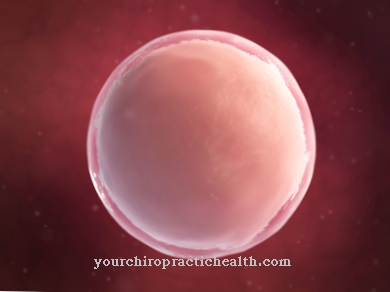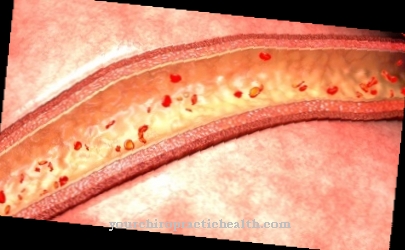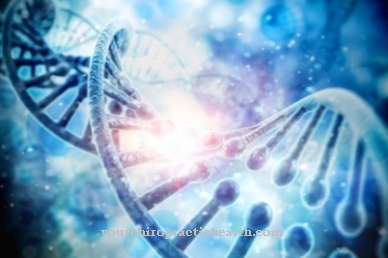With the help of Purine synthesis all living things produce purines. Purine is a component of the DNA bases guanine and adenine as well as the important energy carrier ATP.
What is Purine Synthesis?

The purine synthesis is a biochemical process, at the end of which purines are formed. Purines are organic compounds that occur in all living things. Purines are made from the raw material α-D-ribose-5-phosphate. The human cell converts the substance in several steps. Enzymes catalyze this process and assist in the conversion of one intermediate product into the next.
First, an enzyme converts the α-D-ribose-5-phosphate into α-D-5-phosphoribosyl-1-pyrophosphate (PRPP) by expanding the molecule. This is followed by the conversion of PRPP and glutamine into 5-phosphoribosylamine and glutamate. Then the body can no longer use the substances for the synthesis of other products, but only for the purine synthesis.
The addition of glycine creates a glycine amide ribonucleotide, which transforms an enzyme into a formylglycine amide ribonucleotide and then converts it into phosphoribosylformylglycine amidine and glutamic acid. The intermediate products 5-aminoimidazole ribonucleotide, 5-aminoimodazole-4-carboxylatribonucleotide, SAICAR, AICAR and FAICAR finally produce inosine monophosphate (IMP). The cells can use IMP directly to produce adenosine, guanine and xanthosine.
Purines do not exist as free molecules, but are always linked to other molecules in the form of nucleotides. The finished purine molecule consists of carbon dioxide, glycine, two times 10-formyltetrahydrofolic acid, glutamine and aspartic acid.
Function & task
Some of the genetic information stored in deoxyribonucleic acid (DNA) consists of purines. The DNA consists of building blocks, the nucleotides. These are composed of a sugar molecule (deoxyribose), a phosphoric acid and one of four bases. The bases adenine and guanine are purine bases: their basic structure is a purine to which other molecules bind.
In addition, purine is a component of adenosine triphosphate (ATP). This is the primary energy source in the human organism. Energy is chemically stored in the form of ATP and is available for numerous tasks. The muscles use the ATP for movement, as do some synthesis processes and other processes. In the muscles, ATP also has the effect of a plasticizer: It ensures that the filaments of the muscles can separate from each other. The lack of ATP after death therefore leads to rigor mortis.
In order to release the bound energy, cells and organelles split the ATP into adenosine diphosphate and adenosine monophosphate. The cleavage releases approx. 32 kJ / mol. Furthermore, ATP is used to transmit signals. Within cells it has a function in regulating the metabolism. For example, it serves as a cosubstrate of kinases, which also include the insulin-stimulated protein kinase, which plays a role in connection with blood sugar. Outside of cells, ATP acts as an agonist on purinergic receptors and helps to transmit signals to nerve cells. ATP appears, among other things, in signal transmission in the context of blood flow regulation and the inflammatory reaction.
Illnesses & ailments
Purine synthesis is a complex biochemical process in which errors can easily occur. In order for purine to be created, specialized enzymes have to gradually convert the various substances. Mutations can mean that these enzymes are not properly coded. The genetic material contains information about how the cells have to synthesize the enzymes. Enzymes are made up of protein, which in turn is made up of long chains of amino acids. Each amino acid must be in the right place for the enzyme to be in the right form and function properly.
Errors can occur not only in the production of the enzymes, but also in the genetic code.Mutations ensure that the stored information leads to faulty or incomplete amino acid chains. Such mutations can also affect the enzymes involved in purine synthesis. The diseases resulting from this fall into the category of metabolic diseases and are hereditary.
A mutation in the PRPS1 gene, for example, causes a disruption in purine synthesis. PRPS1 codes for the enzyme ribose phosphate diphosphokinase. The mutation causes the enzyme to be too active. Through various processes, this overactivity increases the risk of gout. Gout (uricopathy) is an intermittent disease. Chronic gout develops after several acute outbreaks. The disease destroys the joints; The changes in the hands and feet are often particularly clearly visible. Pain in the joints, inflammation, and fever are also symptoms of gout. In addition, deformations of the joints, reduced performance, kidney stones and kidney failure can manifest themselves in the long term.
However, defective purine synthesis can not only manifest itself in gout. Another mutation in the PRPS1 gene causes a decrease in the activity of the enzyme ribose phosphate diphosphokinase. As a result, Rosenberg-Chutorian syndrome occurs. This mutation is also a possible cause for a certain form of deafness.
Other genes also encode the enzymes involved in purine synthesis. The ADSL gene is also one of them. Mutations in the ADSL gene lead to adenylosuccinate lyase deficiency. This deficiency is a rare hereditary disease and is inherited as an autosomal recessive trait. The disease manifests itself in newborns, but it can also only appear in childhood. The disease is rather unspecific, for example in an intellectual disability, epilepsy and behavioral disorders that are similar to autism.
Mutations in the ATIC gene can also disrupt purine synthesis. This section of the genetic information encodes the bifunctional purine synthesis protein, which leads to the development of AICA ribosiduria. The literature only documents one case of reduced intelligence, congenital blindness and changes in shape of the knees, elbows and shoulders.



























